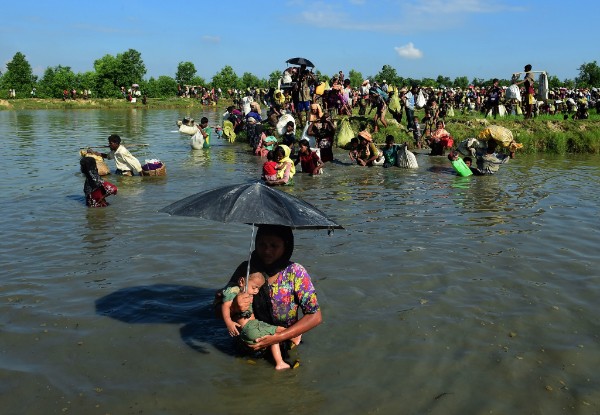| ||||||||||||||||||||||||||||||||||||||||||||
| ||||||||||||||||||||||||||||||||||||||||||||
| ||||||||||||||||||||||||||||||||||||||||||||
|
Friday, December 25, 2015
Thursday, December 24, 2015
In southern Bangladesh, the coastal town of Cox's Bazar is a well-known honeymoon destination. It is famous for its beach, one of the longest unbroken beaches in the world. But only 16 km from the beach, there is a different reality.



TOP: Rohingya refugees who fled from Myanmar wait to be let through by Bangladeshi border guards after crossing the border in Palang Khali, Bangladesh. 17 September 2017. Image credit: Mahmud Hossain Opu LEFT: Rohingya refugees at the Kutupalong-Balukhali extension camp, one of the largest refugee camps in the world, hosting about 600 000 people. Image credit: Mehak Sethi RIGHT: Children in the Kutupalong-Balukhali extension camp. Image credit: Mehak Sethi
Beginning of the crisis
25 August 2018 marks one year since hundreds of thousands of Rohingya people fled persecution and violence in Myanmar's Rakhine State and sought refuge in neighboring Bangladesh. This crisis stands out among recent refugee flows due to the large number of people fleeing in an extremely short period of time: about 655 000 Rohingya women, men and children fled to Bangladesh between 25 August 2017 and mid-December 2017, according to the United Nations. We have not seen a displacement of this level in decades.
The number of Rohingya in Bangladesh stands at about 890 000, according to the most recent situation report from the Inter Sector Coordination Group (as of 31 July). They live in approximately 34 camps in an area spanning about 26 square kilometers. Kutupalong and Balukhali mega camp, known as the Kutupalong-Balukhali extension camp, is one of the largest refugee camps in the world, hosting about 600 000 people. As well as being in one of the world's most densely populated areas, the area is prone to floods and cyclones.
For more information:

How we responded

New technology
The first case of diphtheria, a highly infectious disease, was reported in Cox's Bazar, Bangladesh in November 2017. The disease quickly spiraled to 150 suspected cases a day. Taming the outbreak has been a combined effort of international organizations, nongovernmental organizations and government agencies. One of their key tools has been WHO's Early Warning, Alert and Response System.

Vaccination campaigns
Dozens of immunization officers and field monitors have been working to provide mass vaccinations. This effort was mainly carried out by our Bangladeshi staff members, who have been at the heart of this response. To cover a huge immunization gap among the Rohingya population, more than 4 000 000 doses of vaccines have been delivered during 9 mass vaccination campaigns since September 2017.

Water testing and filters
In Cox's Bazar, water and sanitation continues to be far from optimal. This increases the risk of rapid spread of several communicable and water-borne diseases. Payden, the Regional Adviser for Water and Sanitation in WHO's South-East Asia Regional Office, worked intensively during her deployments to Cox's Bazar, testing water in households and working to get the right water filters for the community.

Logistics
WHO's logisticians are the backbone of every emergency response, including the Rohingya crisis. Since September, they have overseen the supply of more than 160 metric tons of essential medical supplies, from antibiotics, life-saving antitoxins, to tents, hospital beds, and water tanks.

Case investigation
Field epidemiologists have been an important part of this response conducting case investigation and contact tracing. We followed Dr Khadimul Anam Mazhar, who is part of the WHO epidemiology team in Cox's Bazar, Bangladesh, during a case investigations.

Field monitors
The team of immunization field monitors is working across 34 camps to ensure that routine vaccination points have adequate supplies and quality of vaccination as per standard. They visit up to 15 households a day to ensure all members are vaccinated and take part in mobilizing the community.
Year on: what next?
"The word that comes to mind when I just look around at this site of these makeshift houses is the word fragility. This is one of the most fragile situations I have ever seen from a human perspective, from an ecological perspective," said Deputy Director-General of Emergency Preparedness and Response, Dr Peter Salama, as he visited Camp 17 in Kutupalong-Balukhali mega camp, Cox's Bazar, Bangladesh.
Join WHO in taking action
While you are here, take a minute to sign up to our weekly updates and free online courses on health emergencies and we'll be in touch with health advice and latest findings to improve your health and wellbeing.
|
|
|
















